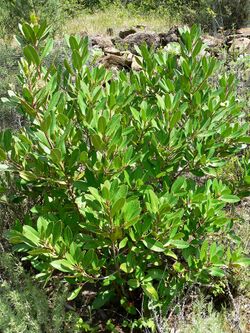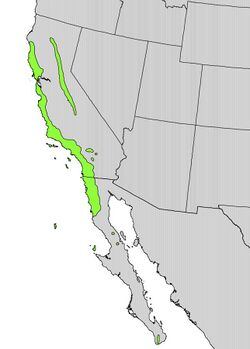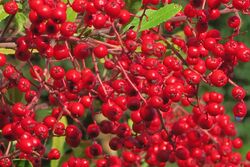Biology:Heteromeles
| Heteromeles | |
|---|---|

| |
| Toyon bush in habitat | |
| Scientific classification | |
| Kingdom: | Plantae |
| Clade: | Tracheophytes |
| Clade: | Angiosperms |
| Clade: | Eudicots |
| Clade: | Rosids |
| Order: | Rosales |
| Family: | Rosaceae |
| Subfamily: | Amygdaloideae |
| Tribe: | Maleae |
| Subtribe: | Malinae |
| Genus: | Heteromeles M.Roem. nom. cons. 1847 |
| Species: | H. arbutifolia
|
| Binomial name | |
| Heteromeles arbutifolia | |

| |
| Natural range | |
| Synonyms[4] | |
| |
Heteromeles arbutifolia (/ˌhɛtɪroʊˈmiːliːz ɑːrˌbjuːtɪˈfoʊliə/;[5] more commonly /ˌhɛtəˈrɒməliːz/ by Californian botanists), commonly known as toyon, is a common perennial shrub native to extreme southwest Oregon,[6][7] California , and the Baja California Peninsula.[4] It is the sole species in the genus Heteromeles.
Toyon is a prominent component of the coastal sage scrub plant community, and is a part of drought-adapted chaparral and mixed oak woodland habitats.[8] It is also known by the common names Christmas berry[9] and California holly.
Description
Toyon typically grows from 2–5 m (rarely up to 10 m in shaded conditions) and has a rounded to irregular top. Its leaves are evergreen, alternate, sharply toothed, have short petioles, and are 5–10 cm in length and 2–4 cm wide. In the early summer it produces small white flowers 6–10 mm diameter in dense terminal corymbs. Flowering peaks in June.[10]
The five petals are rounded. The fruit is a small pome,[11] 5–10 mm across, bright red and berry-like, produced in large quantities, maturing in the fall and persisting well into the winter.[citation needed]
Phytochemistry
The plant has been used as a treatment for Alzheimer's by indigenous people of California and recent research has found a number of active compounds that are potentially beneficial to Alzheimer's treatment. These include icaricide compounds, which protect the blood-brain barrier and prevent infiltration of inflammatory cells into the brain.[12]
Taxonomy
The genera Photinia, Aronia, Pourthiaea, and Stranvaesia have historically been variously combined by different taxonomists.[13] The genus Heteromeles as originally published by Max Joseph Roemer was monospecific, including Photinia arbutifolia Lindl. (1820), as H. arbutifolia (Lindl.) M. Roem, but the name was illegitimate (superfluous) because it included the type of the genus Photinia.[13] This has since been corrected by conservation,[14] and the name is therefore often written as Heteromeles M. Roem. nom. cons. (1847).[citation needed]
Varieties
- Heteromeles arbutifolia var. arbutifolia (Lindl.) M.Roem. – Autonym
- Heteromeles arbutifolia var. cerina (Jeps.) A.E.Murray – Representative of the yellow fruiting specimens of the plant. Sporadic in distribution, and not accepted by most taxonomical authorities.[9]
- Heteromeles arbutifolia var. macrocarpa (Munz) Munz (Island Christmas berry or island toyon) – A very rare insular variety limited to the Channel Islands of San Clemente and Santa Catalina and the Mexican Pacific island of Guadalupe.[15][16] Characterized by shorter, broader, significantly larger leaves with revolute margins and little teeth, and floriferous inflorescences with larger fruits (8 to 10 mm).[9] It is more susceptible to fungal infections of Spilocaea than the common toyon.[17]
Toxicity
Toyon pomes are acidic and astringent, and contain a small amount of cyanogenic glycosides, which break down into hydrocyanic acid on digestion. This is removed by mild cooking.[18] Most fruits from plants in the family Rosaceae, including apples, apricots, peaches, cherries, and plums, contain cyanide.[12]
Some pomes, though mealy, astringent and acid when raw, were eaten fresh, or mashed into water to make a beverage.[citation needed]
A 2016 study found 5g of the dried berries (used as a treatment for Alzheimer's) to be safe. The study also found no cyanogenic compounds in the plant.[12]
Uses
The pomes provided food for local Native American tribes, such as the Chumash, Tongva, and Tataviam. The pomes also can be made into a jelly. Native Americans also made a tea from the leaves as a stomach remedy. Most were dried and stored, then later cooked into porridge or pancakes. Later settlers added sugar to make custard and wine.[19] The plants were also often cooked over a fire to remove the slightly bitter taste by Californian tribes.[20]
The Tongva (who called the plant ashuwet) ate the berries fresh, boiled and left them in an earthen oven for 2 to 3 days, roasted them, or made them into a cider. Pulverized flowers were steeped into hot water to make tea which could be used to ease gynecological ailments. For stomach pains, bark and leaves are steeped in hot water to make tea. The same tea can serve as a seasonal tonic and ease other body pains. Also, applying mashed ashuwet to sores eases pain. Infected wounds are washed using an infusion of bark and leaves.[21] The ʔívil̃uqaletem also called the plant ashwet. They often consumed the fruit both raw and cooked.[20]
Cultivation
Toyon can be grown in domestic gardens in well-drained soil, and is cultivated as an ornamental plant as far north as Southern England. It can survive temperatures as low as -12 °C.[citation needed] In winter, the bright red pomes (which birds often eat voraciously) are showy.[citation needed]
Like many other genera in the Rosaceae tribe Maleae, toyon includes some cultivars that are susceptible to fireblight.[22] It survives on little water, making it suitable for xeriscape gardening, and is less of a fire hazard than some chaparral plants.[23]
They are visited by butterflies, and have a mild, hawthorn-like scent. The fruit are consumed by birds, including mockingbirds, American robins, cedar waxwings and hermit thrushes.[24] Mammals including coyotes and bears also eat and disperse the pomes.[citation needed]
Culture
In 1921,[25] collecting toyon branches for Christmas became so popular in Los Angeles that the State of California passed a law forbidding collecting on public land or on any land not owned by the person picking any plant without the landowner's written permission (CA Penal Code § 384a).[26][27]
Toyon was adopted as the official native plant of the city of Los Angeles by the LA City Council on April 17, 2012.[28]
See also
- California native plants
- Asphondylia photiniae - midge induced galls on toyon berries
References
- ↑ IUCN SSC Global Tree Specialist Group.; Botanic Gardens Conservation International (BGCI). (2020). "Heteromeles arbutifolia". IUCN Red List of Threatened Species 2020: e.T156822115A156822117. doi:10.2305/IUCN.UK.2020-1.RLTS.T156822115A156822117.en. https://www.iucnredlist.org/species/156822115/156822117. Retrieved 23 September 2021.
- ↑ Jepson Flora Project (1993) Heteromeles arbutifolia, University of California, Berkeley
- ↑ Tropicos.org, http://www.tropicos.org/Name/50051852, retrieved 11 November 2016
- ↑ 4.0 4.1 James B. Phipps (2015), "Heteromeles arbutifolia (Lindley) M. Roemer, Fam. Nat. Syn. Monogr. 3: 105. 1847", Flora of North America, 9, http://www.efloras.org/florataxon.aspx?flora_id=1&taxon_id=250100233
- ↑ Sunset Western Garden Book, 1995:606–607
- ↑ "Final Environmental Impact Statement - Appendices". Smith River National Recreation Area Restoration and Motorize Travel Management (United States Department of Agriculture): 192. December 2016. https://www.fs.usda.gov/nfs/11558/www/nepa/87269_FSPLT3_3909125.pdf. "Heteromeles arbutifolia is found in Oregon and the location southwest of Pappas Flat is not the northernmost site in the Pacific Northwest. Additionally, this site is adjacent to Highway 199 and will not be affected by the proposed actions, and is outside the geographic scope of the project.".
- ↑ Wood, Wendell (February 2008). "Toyon Joins the List of Oregon's Native Shrubs". Bulletin of the Native Plant Society of Oregon 41 (2): 11, 18. https://www.npsoregon.org/bulletin/2008/NPSO_0802.PDF.
- ↑ C.M. Hogan, 2008
- ↑ 9.0 9.1 9.2 James B. Phipps (2015), "Heteromeles M. Roemer, Fam. Nat. Syn. Monogr. 3: 100, 105. 1847. [name conserved"], Flora of North America, 9, http://www.efloras.org/florataxon.aspx?flora_id=1&taxon_id=115321
- ↑ Heteromeles arbutifolia at iNaturalist
- ↑ "Heteromeles arbutifolia, in Jepson Flora Project". Regents of the University of California. http://ucjeps.berkeley.edu/cgi-bin/get_IJM.pl?tid=28072.
- ↑ 12.0 12.1 12.2 Wang; Dubois; Young; Lien; Adams (7 Jul 2016). "Heteromeles Arbutifolia, a Traditional Treatment for Alzheimer's Disease, Phytochemistry and Safety". Medicines 3 (3): 17. doi:10.3390/medicines3030017. PMID 28930127.
- ↑ 13.0 13.1 Nesom, G.L.; Gandhi, K. (2009), "(1884–1885) Proposals to conserve the names Photinia, with a conserved type, and Heteromeles (Rosaceae)", Taxon 58 (1): 310–311, doi:10.1002/tax.581041
- ↑ International Code of Nomenclature for algae, fungi, and plants: Appendices II-VIII (Appendix III), http://botany.si.edu/references/codes/props/index.cfm
- ↑ Rebman, J. P.; Gibson, J.; Rich, K. (2016). "Annotated checklist of the vascular plants of Baja California, Mexico". Proceedings of the San Diego Society of Natural History 45: 245. http://sdplantatlas.org/pdffiles/BajaChecklist2016.pdf.
- ↑ de la Luz, J. L. L., Rebman, J. P., & Oberbauer, T. (2003). On the urgency of conservation on Guadalupe Island, Mexico: is it a lost paradise?. Biodiversity & Conservation, 12(5), 1073-1082.
- ↑ Raabe, R. D., & Gardner, M. W. (1972). Scab of Pyracantha, loquat, toyon, and kageneckia. Phytopathology, 62, 914-916.
- ↑ Jim Moore. "Toyon – California's Own Christmas Berry Can Be Toxic |". https://www.mountainvalleyliving.com/2017/11/food-from-the-wild-toyon/. Retrieved 2021-12-27.
- ↑ "Ethnobotany of southern California native plants: Toyon (Heteromeles arbutifolia)". http://www.ethnoherbalist.com/southern-california-native-plants-medicinal/toyon-berries/.
- ↑ 20.0 20.1 Bean, John Bean; Saubel, Katherine Siva (1969). Temalpakh (from the Earth): Cahuilla Indian Knowledge and Usage of Plants. Malki Museum Press. ISBN 978-0939046249. http://malkimuseum.org/product/temalpakh-cahuilla-indian-knowledge-and-usage-of-plants/.
- ↑ "Ashuwet". http://www.runajambi.net/tongva/californiaholly.htm.
- ↑ Austin Hagan, Edward Sikora, William Gazaway, Nancy Kokalis- Burelle, 2004. Fire Blight on Fruit Trees and Woody Ornamentals, Alabama A&M and Auburn Universities
- ↑ Dave's Garden
- ↑ Kaplan, Alan; Hawkes, Alison (December 22, 2016), "Ask The Naturalist: How Important Are Red Toyon Berries To the Winter Food Chain?", Bay Nature, http://baynature.org/article/ask-the-naturalist-how-important-are-all-those-red-berries-we-see-to-the-winter-food-chain/
- ↑ November 11, 1921 Santa Ana Register, "Holly Trees of County to be saved by Vandals" State Legislature enacts law prohibiting the mutilation or sale of California Holly taken from public lands.
- ↑ McKINNEY, JOHN (December 6, 1986). "California Holly Adds Color to Trail Up Mt. Hollywood". Los Angeles Times: p. 12. http://articles.latimes.com/1986-12-06/news/vw-1626_1_hollywood-trail.
- ↑ California Penal Code Section 384a
- ↑ "Item No. (28)". Journal/Council Proceedings. LA City Council. http://ens.lacity.org/clk/oldactions/clkcouncilactions276843_04272012.pdf.
External links
- {{citation
| mode = cs1 | title = Heteromeles salicifolia | work = Germplasm Resources Information Network (GRIN) | url = https://npgsweb.ars-grin.gov/gringlobal/taxonomydetail.aspx?414959 | publisher = [[Organization:Agricultural Research ServAgricultural Research Service (ARS), United States Department of Agriculture (USDA) | access-date = }}
- C. Michael Hogan (2008) Toyon: Heteromeles arbutifolia, iGoTerra.com
- Photos of Toyon in flower and fruit
- University of Michigan: Dearborn—Native American Ethnobotany (Heteromeles arbutifolia)
- Los Angeles City Clerk—Council Files: Toyon
- CalFlora database: Heteromeles arbutifolia
- The Living Wild Project: Toyon
- USDA Plants Profile for Heteromeles arbutifolia (toyon)
- Heteromeles arbutifolia—U.C. Photo gallery
Wikidata ☰ Q2655434 entry
 |








